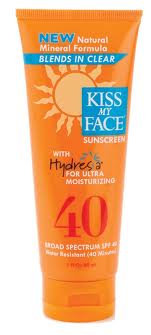 Can a little cream block the sun's ultraviolet rays? The EWG says some can. Photo: NASA pic.twitter.com/yrUtGYQKThe key to a sunscreen's effectiveness is its ability to knock out both UVA rays (which penetrate the skin and cause tanning, wrinkles and skin cancer) and UVB rays (which stay on the top layers of skin and cause tanning, sunburn and skin cancer.) All sunscreens protect against burning from UVB rays (SPF ratings reflect only the extent of protection against UVB.) But according to the Environmental Working Group's report on sunscreens, many do not provide adequate protection from UVA rays--hence the oft' noted problem of regular sunscreen users getting tanned...and getting skin cancer.
Can a little cream block the sun's ultraviolet rays? The EWG says some can. Photo: NASA pic.twitter.com/yrUtGYQKThe key to a sunscreen's effectiveness is its ability to knock out both UVA rays (which penetrate the skin and cause tanning, wrinkles and skin cancer) and UVB rays (which stay on the top layers of skin and cause tanning, sunburn and skin cancer.) All sunscreens protect against burning from UVB rays (SPF ratings reflect only the extent of protection against UVB.) But according to the Environmental Working Group's report on sunscreens, many do not provide adequate protection from UVA rays--hence the oft' noted problem of regular sunscreen users getting tanned...and getting skin cancer.
In its review, EWG found "56 beach and sport sunscreens that do not contain any of the active ingredients known to protect against UVA rays. More than half of all sunscreens by Panama Jack and Australia Gold were in this category." More than half of all sunscreens on the market did not meet the the much stricter European guideline for UVA protection, offering weak protection against UVA at best.
Besides protection from ultraviolet rays, ingredient safety is yet another area in which sunscreens are letting the consumer down. According to the EWG, some sunscreen ingredients are potentially toxic:
"Both UV radiation and many common sunscreen ingredients generate free radicals that damage DNA and skin cells, accelerate skin aging and cause skin cancer." For example, oxybenzone, a commonly used active ingredient in sunscreen, is thought to be a hormone disrupting chemical with the potential to encourage growth of breast cancer cells.
Perhaps most shocking, sunscreen inadequacies are widespread--and not just isolated to a few obscure brands. According to the EWG, serious problems exists for even the most common sunscreen brands on the market, including those from Neutrogena and Aveeno--both of which scored in the "caution" and "avoid" categories of the EWG Sunscreen Guide.
On the other hand, sunscreens from organic companies (often assumed to be less effective) scored highest in the EWG report. EWG gives a thumbs up to sunscreens from companies like Aubrey, Kiss My Face and ThinkSport (the LiveStrong brand) that use mineral blocks like titanium dioxide and zinc oxide, which are stable in sunlight, offer UVA protection and do not appear to penetrate the skin, which is how some ingredients can lead to increased cancer risk. The EWG report is exhaustive, but highly searchable with an APP for on-the-spot smart shopping.
Why are you not getting the SPF that's on the label? It's all in how you apply.
The EWG's top rated sunscreens. Join our quest to find a highly rated sunscreen that doesn't turn you white as a ghost.
 Tuesday, June 12, 2012 at 1:37PM
Tuesday, June 12, 2012 at 1:37PM  Among EWG's Top Rated Sunscreens
Among EWG's Top Rated Sunscreens According to the EWG: "After reviewing the evidence, EWG determined that mineral sunscreens have the best safety profile of today’s choices. They are stable in sunlight and do not appear to penetrate the skin. They offer UVA protection, which is sorely lacking in most of today’s sunscreen products. Mexoryl SX (ecamsule) is another good option, but it’s available in very few formulations." (iwellville found Mexoryl SX in a La Roche-Posay Anthelios 40 Sunscreen Cream SPF 40, but the EWG APP marked the cream down for other ingredients of concern.)
According to the EWG: "After reviewing the evidence, EWG determined that mineral sunscreens have the best safety profile of today’s choices. They are stable in sunlight and do not appear to penetrate the skin. They offer UVA protection, which is sorely lacking in most of today’s sunscreen products. Mexoryl SX (ecamsule) is another good option, but it’s available in very few formulations." (iwellville found Mexoryl SX in a La Roche-Posay Anthelios 40 Sunscreen Cream SPF 40, but the EWG APP marked the cream down for other ingredients of concern.) What we love most about the EWG APP: It allows users to type in their own sunscreen brand, find the rating, and then scroll through the ingredient list and see what concerns the EWG and why. This way all of us can make informed decisions.
What we love most about the EWG APP: It allows users to type in their own sunscreen brand, find the rating, and then scroll through the ingredient list and see what concerns the EWG and why. This way all of us can make informed decisions.

